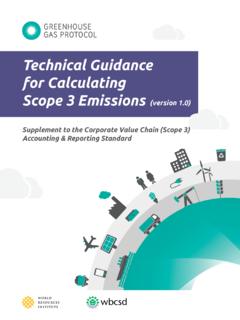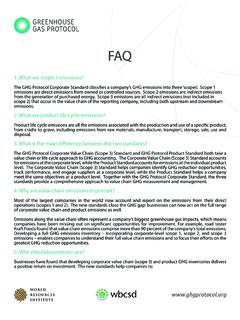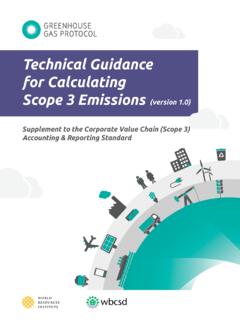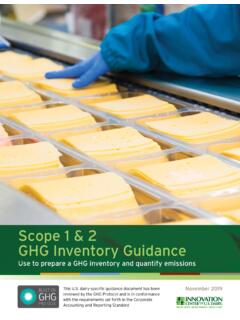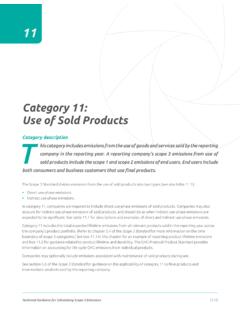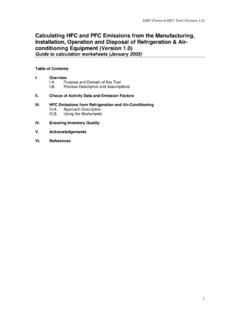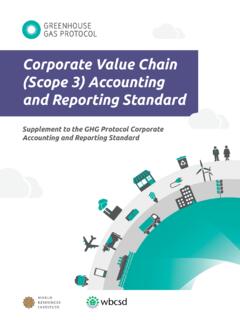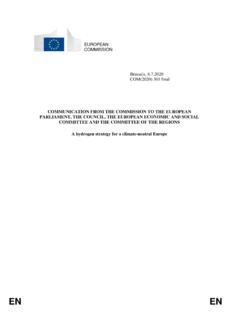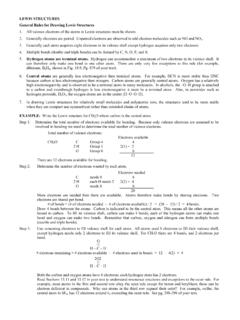Transcription of GHG Protocol Scope 2 Guidance
1 An amendment to the GHG Protocol Corporate Standard GHG Protocol Scope 2 Guidanceexecutive Summary2 Scope 2 Guidance1. Introduction to Scope 2 emissionsSince the publication of the Corporate Standard in 2004, companies around the world have been seeking innovative strategies to measure and manage their greenhouse gas (GHG) emissions. For most companies, emissions from purchased electricity, steam, heating, and cooling (termed Scope 2 emissions) represent a significant emission source and operational cost. To reduce these emissions, companies typically turn to energy conservation, efficiency upgrades, and low-carbon electricity supply.
2 But the mechanisms that allow corporate consumers to choose a low-carbon grid-delivered energy supply vary by electricity market. Some companies can work with their electricity suppliers to purchase a low-carbon product, or enter into power purchase agreements with individual generators. Consumers can also separately buy electricity attributes via certificates that conveys information about energy production. 2. The need for Scope 2 Guidance and international consistencyAccurately accounting for Scope 2 emissions is essential in order to manage and reduce them. However, companies have not had standards that address whether and how emissions from these diverse instruments should be accounted for in a GHG inventory.
3 As a result, Scope 2 emission reports have varied between companies significantly, leaving internal and external decision-makers unable to assess and compare corporate performance. The uncertainty around whether and how energy purchases contribute to meeting Scope 2 emission reduction goals has impeded corporate investment in, and demand for, low-carbon energy. 3. What this Guidance providesThis Guidance provides a unified, internationally-consistent, transparent basis for companies to account for electricity purchases in their GHG inventory. The Guidance acts as an amendment to the Corporate Standard, revising and updating the previously brief treatment of Scope 2 accounting boundaries and methods.
4 It introduces: Requirements: Accounting and reporting requirements which companies must meet to be in conformance with the Corporate Standard. Quality Criteria: A list of Scope 2 Quality Criteria that all electricity purchasing instruments termed here contractual instruments need to meet in order to be used in market-based method accounting. Recommendations: Additional features companies should disclose about their electricity purchases, as well as other metrics such as total electricity, steam, heating, and cooling consumed, and what percentage of corporate operations have market-based method data available. The Greenhouse Gas (GHG) Protocol is a multistakeholder partnership of businesses, nongovernmental organizations (NGOs), governments, and others convened by the World Resources Institute (WRI) and the World Business Council for Sustainable Development (WBCSD).
5 Launched in 1998, the GHG Protocol seeks to develop internationally accepted GHG accounting and reporting standards and tools to promote their adoption in order to achieve a low emissions economy worldwide. All GHG Protocol standards and Guidance are available at Scope 2 Guidance represents a policy- neutral , collaborative solution guided by GHG Protocol principles. It was developed over four years of international consultation and discussion with participation from businesses, NGOs, GHG reporting programs, energy utilities and retailers, renewable energy certification programs, government agencies, and scientific and academic institutions from around the world.
6 It included scoping workshops conducted in London, Washington DC, and Mexico City in 2010 and 2011; a Technical Working Group (TWG) that contributed to discussion papers, conference presentations, and draft proposals on accounting and reporting solutions; and a public comment period in spring 2014, including six webinars and three in-person workshops in London, Dusseldorf, and Washington 1 How this Guidance was developed 3 Executive Summary4. Who should read this GuidanceThis Guidance amends and adds to the Corporate Standard requirements on Scope 2 accounting and reporting. All organizations compiling a corporate GHG inventory following the Corporate Standard including companies, governments, NGOs and other organizations should use this Guidance .
7 The term companies is used throughout this document as shorthand for any organization compiling a corporate inventory. Electricity suppliers, advocates, and policy makers will also be well served to understand the new GHG accounting and reporting requirements, as well as the Scope 2 Quality Criteria (see Chapter 7). These affect whether a given energy label, green power program, or other instrument can be used in corporate GHG inventories, and will influence the type of energy products and information companies request. Market-based electricity tracking and purchasing programs inherently interact with policies affecting the electricity sector, such as emission cap-and-trade regulations, supplier fuel mix and emissions disclosure rules, supplier quotas to source renewable energy, and specific subsidies or support schemes for renewable energy.
8 Policy makers play a key role in determining the relationship between voluntary purchasing programs and regulatory policies. 5. Key changes introduced by the For most companies, Scope 2 is no longer one number it is two. For companies with any operations in markets providing product or supplier-specific data in the form of contractual instruments, companies shall report Scope 2 according to a location-based method and a market-based method. Each method s results reflect different risks and opportunities associated with emissions from electricity1 use, and can inform different decisions and levers to reduce emissions.
9 Companies shall choose which method s results to use for goal setting and other 2 Key TermsSome terms used in this Guidance are used for precision but are synonymous with other more familiar terms. For example:Contractual instruments: Any type of contract between two parties for the sale and purchase of energy bundled with attributes about the energy generation, or for unbundled attribute claims. Markets differ as to what contractual instruments are commonly available or used by companies to purchase energy or claim specific attributes about it, but they can include energy attribute certificates (RECs, GOs, etc.), direct contracts (for both low-carbon, renewable, or fossil fuel generation), supplier-specific emission rates, and other default emission factors representing the untracked or unclaimed energy and emissions (termed the residual mix) if a company does not have other contractual information that meets the Scope 2 Quality attribute certificate: A category of contractual instrument that represents certain information (or attributes) about the energy generated, but does not represent the energy itself.
10 This category includes a variety of instruments with different names, including certificates, tags, credits, or generator declarations. For the purpose of this Guidance , the term energy attribute certificates or just certificates will be used as the general term for this category of generation facility: Any technology or device that generates energy for consumer use, including everything from utility-scale fossil fuel power plants to rooftop solar supplier: Also known as an electric utility, this is the entity that sells energy to consumers and can provide information regarding the GHG intensity of delivered : Here used to mean the entity that owns or operates an energy generation facility.

